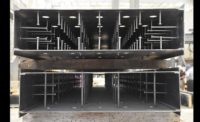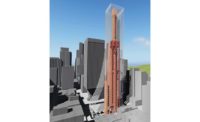A recent successful load test on a steel-fiber-reinforced-concrete beam, free of congestion-causing diagonal reinforcing steel, promises to positively impact constructibility of tall, moment-resisting frames in seismic zones. Using SFRC, engineers can reinforce high-aspect-ratio link beams, which span openings in shear walls, as regular beams, say the test’s researchers.

“We have a design for which you do not need diagonal bars, and you can still achieve large drift capacity under very high shear forces,” says Gustavo J. Parra-Montesinos, the test’s lead researcher and a Dept. of Civil and Environmental Engineering professor at the University of Michigan, Ann Arbor. In the future, engineers will be able to use steel fibers to replace transverse reinforcement for confining concrete or shear strength in seismic applications, he says.
Sponsored by the school and conducted on April 8, the test followed earlier tests on SFRC link beams made of the same concrete mix but with lower aspect ratios. Rotated 90° and tested to 9% drift and failure, the beam was 5 ft, 6 in. long and 1 ft, 8 in. high. The high aspect ratio was 3.3.
The specimen was designed so the shear-force demand would be close to the maximum allowable shear in the code. “We wanted a beam that really gets stressed—almost like the worst-case scenario,” says Parra-Montesinos.
The link-beam researchers think they also can eliminate diagonal rebar in somewhat lower-aspect-ratio link beams. They are seeking funds for more tests.



Post a comment to this article
Report Abusive Comment